


© 2004-2022 Thomas Jäkel
Tropidolaemus laticinctus - North Sulawesi
Update November 2020
*
Tr

An enigmatic species of Tropidolaemus. An image contributed by Helmut
Sommerauer. Reportedly photographed by a local guide in Tangkoko Nature Reserve
of North Sulawesi.This red-banded form was recently re-described as
Tropidolaemus laticinctus by Kuch et al. 2007, in ZOOTAXA 1446: 1-20.
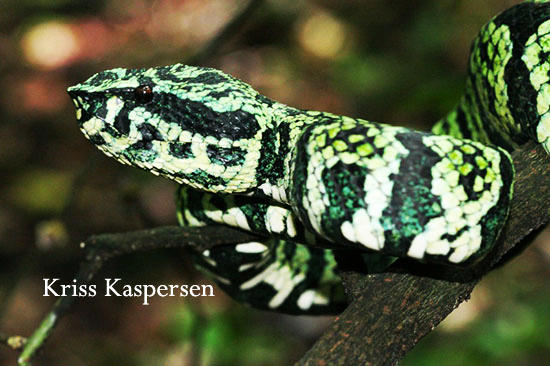
A black-green form of, I guess. T. laticinctus. I am also quite sure that this is a female.
This image contradicts the species description, which claims absence of sexual
dimorphism.

Full view of the animal above.
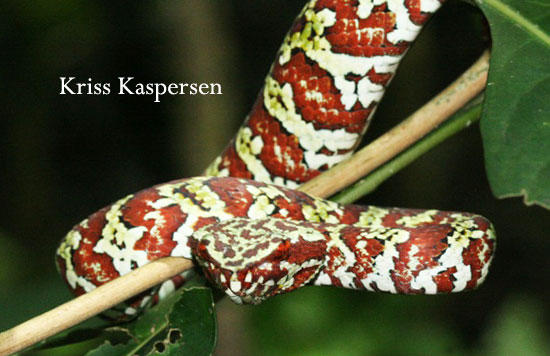
The red-banded form of T. laticinctus, photographed by Kriss Kaspersen in the same
location like the specimen above.
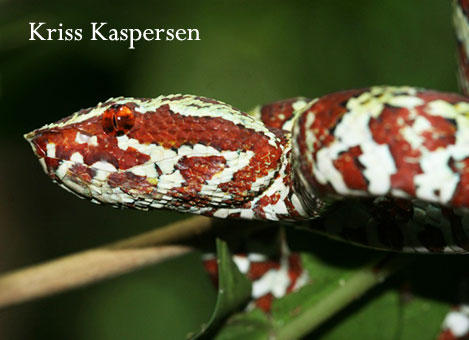
Close-up of the head of the same viper as shown above. I would address
this specimen as a male (head dimensions, relatively large eye), but
without knowing the exact size this remains guesswork.
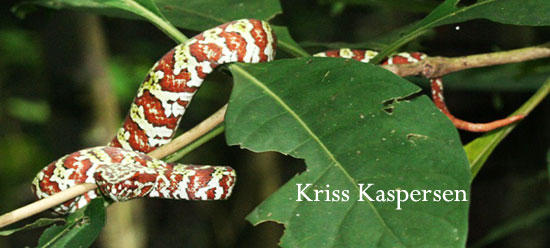
Whole view of the same animal as above.
Wagler’s Viper Site - North Sulawesi 2
A red-banded form of Wagler's Viper from North Sulawesi has been recently re-discribed as
Tropidolaemus laticinctus (see reference above). This form obviously occurs in the same habitats
like the green Tropidolaemus subannulatus shown above. Two Tropidolaemus species with
overlapping distributions: that is interesting! What are the evolutionary forces that made this
happen? So far we don't know the answer.
To date, T. laticinctus was regarded to be a red-banded species. The 2007 paper decribes females
and males with similar color, banding pattern, and size (actually, only the length of the holotype is
given), providing no discussion why that is so in a genus that is known to show an extreme form of
sexual dimorphism. Furthermore, no evidence is provided what identifies males and females, i.e. no
hemipenis or other sexual organs are presented with regard to the type specimens (such a
sloppyness plagues also other species descriptions). The lack of dimorphism is used by the authors
as a major feature to distinguish T. laticinctus from T. subannulatus.
So, I was wondering what a strange species of Tropidolaemus that is, until I saw the images of
Kriss Kaspersen, who was lucky enough to photograph a blackish-green form of T. laticinctus (see
below) in its natural habitat and so kind to let me show it here. Thanks a lot, Kriss. I assume that
this is the female of T. laticinctus, whereas adults of the red form are males. Look at the
proportions of the head and position of the eye to tell the difference between male and
female...very similar to other Tropidolaemus species! If one blends out colors, banding patterns
are quite similar. I hope we can see further images of this stunning viper in the future. Stay
tuned.

Tropidolaemus laticinctus photographed in North Minahasa, about 420m above sea level.
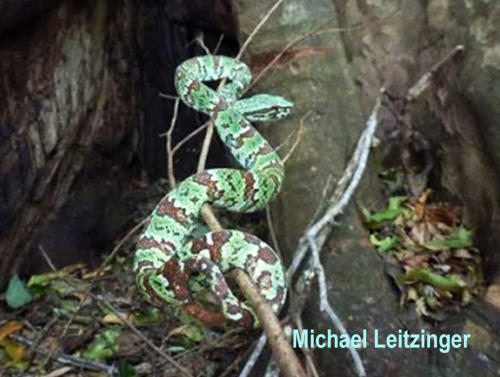
A specimen in Tangkoko-Dua-Saudara-Batu-Angus Nature Reserve; is this a male
or female? Difficult to tell without knowing the exact size, but may be a sub-adult
female.
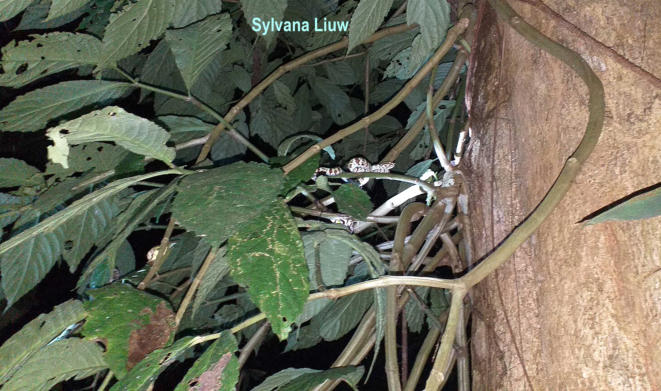
A specimen from North Tomohon (680 m above sea level) in a tree about 4 m above ground.


© 2004-2021 Thomas Jäkel

Tropidolaemus laticinctus (as of April 2012)
*
Tr
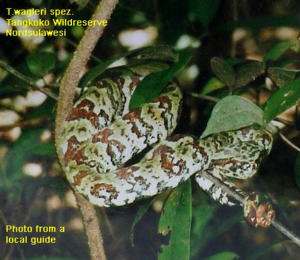
An enigmatic new species of Tropidolaemus. An image contributed by Helmut
Sommerauer. Reportedly photographed in Tangkoko Nature Reserve of North
Sulawesi.This red-banded form was recently re-described as Tropidolaemus
laticinctus by Kuch et al. 2007, in ZOOTAXA 1446: 1-20.

A black-green form of, I guess. T. laticinctus. I am also quite sure that
this is a female. This image contradicts the species description, which
claims absence of sexual dimorphism.
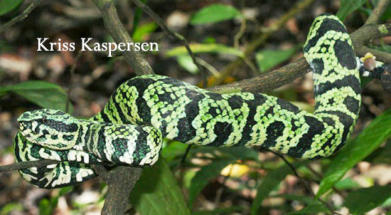
Full view of the animal above.
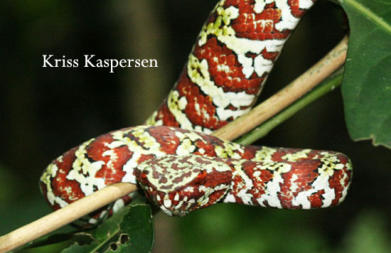
The red-banded form of T. laticinctus, photographed by Kriss Kaspersen
in the same location like the specimen above.
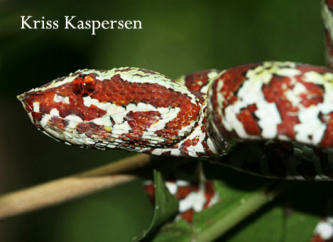
Close-up of head of the same viper as shown above. Based on
the (relatively large) size of the eye relative to the head, I
assume this could be a male (if it is adult).
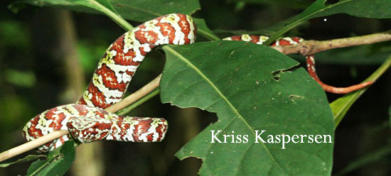
Whole view of the same animal as above.
Wagler’s Viper Site -
North Sulawesi 2
A red-banded form of Wagler's Viper from North Sulawesi has been recently re-
discribed as Tropidolaemus laticinctus (see reference above). This form obviously
occurs in the same habitats like the green Tropidolaemus subannulatus shown above.
Two Tropidolaemus species with overlapping distributions: that is interesting! What
are the evolutionary forces that made this happen? So far we don't know the
answer.
To date, T. laticinctus was regarded to be a red-banded species. The 2007 paper
decribes females and males with similar color, banding pattern, and size (actually,
only the length of the holotype is given), providing no discussion why that is so in a
genus that is known to show an extreme form of sexual dimorphism. Furthermore,
no evidence is provided what identifies males and females, i.e. no hemipenis or other
sexual organs are presented with regard to the type specimens (such a sloppyness
plagues also other species descriptions). The lack of dimorphism is used by the
authors as a major feature to distinguish T. laticinctus from T. subannulatus.
So, I was wondering what a strange species of Tropidolaemus that is, until I saw
the images of Kriss Kaspersen, who was lucky enough to photograph a blackish-
green form of T. laticinctus (see below) in its natural habitat and so kind to let me
show it here. Thanks a lot, Kriss. I assume that this is the female of T. laticinctus,
whereas adults of the red form are males. Look at the proportions of the head and
position of the eye to tell the difference between male and female...very similar to
other Tropidolaemus species! If one blends out colors, banding patterns are quite
similar. I hope we can see further images of this stunning viper in the future. Stay
tuned.
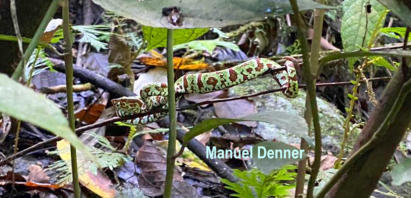
Tropidolaemus laticinctus photographed in North Minahasa, about
420m above sea level.
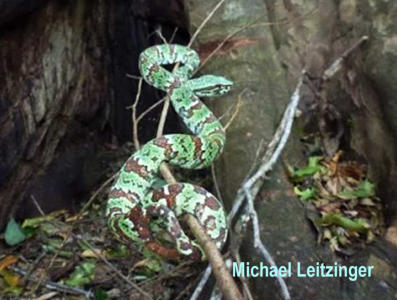
A specimen in Tangkoko-Dua-Saudara-Batu-Angus Nature Reserve; is this
a male or female? Difficult to tell without knowing the exact size, but
may be a sub-adult female.
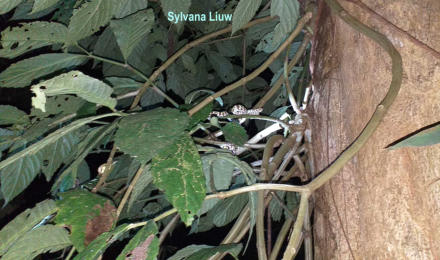
A specimen from North Tomohon (680 m above sea level) in a tree about 4 m
above ground.


- Home
- Wagler's Viper Site (WVS)
- General Husbandry - WVS
- Breeding - WVS
- Health Problems - WVS
- Taxonomy and Phylogenetics - WVS
- Biology - WVS
- Geographic Variability - WVS
- How Females Change - WVS
- Venom - WVS
- Image Map - WVS
- Special: T. laticinctus - WVS
- Special: North Sumatra - WVS
- Special: Video on Mating - WVS
- Special: North Sulawesi - VVS
- Biological Rodent Control - BRC
- Rodent Management Laos - BRC
- Gallery
- Contact









